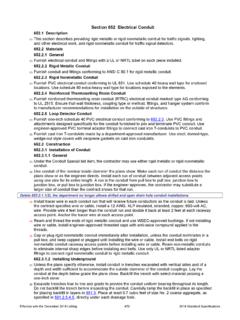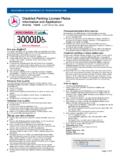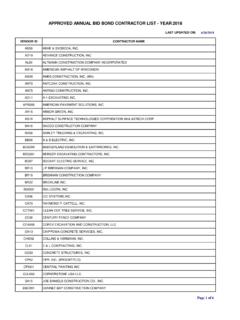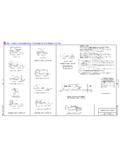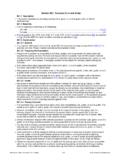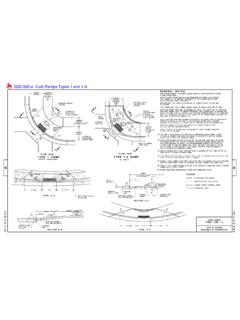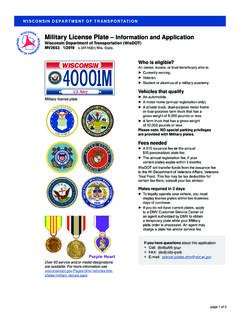Transcription of Facilities Development Manual Wisconsin Department of ...
1 Page 1 Facilities Development Manual Wisconsin Department of Transportation Chapter 11 Design Section 25 Intersections at Grade FDM 11-25-1 General March 31, 2017 Design Consideration Design an intersection to either rural or urban design criteria depending on its location and the type of existing or planned Development in the area.
2 Design intersections located to serve a present or future residential or commercial area to urban standards with specific consideration of the current or eventual need for a new or a change in intersection traffic control or type cross walks, pedestrian signals, expected traffic volumes, and size of vehicles expected. Consult with the region planning staff to determine the type of Development planned in the area of the intersection. It is very important to include traffic Operations personnel early in the scoping of a project to assist the design team with the traffic control, signage, and pavement marking analysis and decision-making.
3 In addition, safety countermeasure decisions and the need for Facilities that serve large trucks and oversized-overweight (OSOW) vehicles must also involve traffic Operations personnel and the Regional Freight Coordinator. Try to keep the size of intersections to a minimum, including roundabouts. Designing intersections for large trucks requires large corner radii, which substantially increases the size of the intersection. Larger intersections generally have greater crash potential, are more difficult to delineate, may be more confusing for drivers and other users, require more right-of-way, and significantly increase pedestrian and bicycle crossing times and distances.
4 References for this chapter include Chapter 9 of the AASHTO GDHS1 and other sources as noted. Specific factors and features to consider are: - Safety - some factors that affect intersection safety include: - Number of approaches - Number of potential conflict points - Type of traffic control and advance signing (see FDM 11-25-3; also, see WisDOT's traffic Engineering Operations and Safety Manual (TEOpS) and traffic signal design Manual (TSDM) and consult with traffic Operations) - Approach sight distance, , the visibility of the intersection to an approaching driver (see FDM 11-10-5) - Intersection Sight distance (see FDM 11-10-5) - Intersection skew angle (see FDM ) - Whether the intersection is located on a curve (see FDM ) - Street lighting - Turn Lanes (see FDM and.)
5 Also see FDM 11-25-5 and FDM 11-25-10) - Auxiliary lanes (see FDM 11-25-35) - Access management (see FDM FDM 11-25-20, FDM 11-5-5, FDM chapter 7 and HMM Chapter 91) - Intersection radii and channelization (see FDM 11-25-10 and FDM 11-25-25; also see SDD 9A1) - Functional classes of the intersecting roadways (see FDM 11-25 Table ; also see FDM 11-15-1 Attachment); - Designated Long Truck Routes, 75' Restricted Truck Routes, 65' Restricted Truck routes and statewide Oversized-overweight Truck Route (OSOW-TR) (see FDM ). - Topography and surrounding land uses - examples: - The length of the crossroad available for traffic generating Development including potential extensions - In urban and suburban or transitional areas, there is the potential for Development to occur along the highway or adjacent frontage roads.
6 traffic from this Development will feed into the crossroad. 1 (1) A Policy on Geometric Design of Highways and Streets 2004, 5th edition. AASHTO, 2004. FDM 11-25 Intersections at Grade Page 2 - Commercial or industrial zoned areas may attract truck terminals or other truck generators.
7 - Schools, parks, residential developments are examples of destinations that should anticipate bicycle, pedestrian and transit increases as well as motor vehicles. - Corridor Considerations - The appropriate design and traffic control of an individual intersection must provide a safe environment with adequate capacity, and also reflect the needs of adjacent intersections and the corridor as a whole. As such, isolated intersection designs may benefit from features not dictated by capacity alone. These features should be consistent with the overall facility, examples of which may include: turn lanes, separation of turn lanes from adjacent through lanes, raised medians, islands, and on-road bicycle accommodations.
8 Right-of-way may also need to be preserved for future corridor-based improvements. - Regulatory speed limits are rarely reduced just for intersections. Guidance on Speed Limits is provided in the traffic Engineering, Operations and Safety Manual TEOpS 13-5. If a speed reduction is desired for an intersection, work with Region traffic staff, as they are responsible for any speed limit changes. Also by statutory authority (ss and ), speed zone declarations are required when the traffic on a STH is required to reduce speed as a result of a regulatory speed limit sign installation . The Development of a declaration needs to be based on an engineering study coordinated with Region traffic staff.
9 - traffic characteristics: - Current and expected daily traffic volumes and turning movements (see FDM 3-10-10) - Current and expected Design hour volumes and turning movements (see FDM 3-10-10) - Composition of traffic - including trucks and buses (and bicycles) (see FDM 3-10-10) - OSOW vehicles - including on roads that are not currently on the OSOW Truck Route (OSOW-TR), but which contain an OSOW origination point, or a recurring OSOW destination ( , a manufacturing plant or a gravel pit) (see FDM and FDM ). - Design vehicle (see FDM ) - Vehicle speeds - Level of Service (see FDM 11-25-3 and FDM 11-5-3) - traffic Control Warrants and Design: - See FDM - Crash experience including numbers, rates, locations, types, and severity - Road user types - motorists, transit, bicyclists, and pedestrians - Sidewalk approaches and crosswalks (see FDM 11-46-5 and FDM 11-46-10) - Pedestrian crossing distance and Pedestrian Clearance Time - Geometry and cross-sections of the approach roadways and the intersection.
10 - Drainage requirements (see FDM chapter 13) - Proximity and traffic volumes of driveways and other roads (see FDM ; also see FDM 11-5-5 and FDM 11-25-20; Refer to FDM 11-30-1 regarding ramp terminal spacing) - Right-of-way requirements (see FDM ) - Cost and Potential impacts Right-of-Way Considerations Public right-of-way at STH intersections needs to accommodate design geometrics (for existing & future conditions), operations-related infrastructure, and adequate sight distance. All WisDOT maintained signal & electrical equipment must either be located within the public right-of-way or within a permanent limited easement (PLE).
